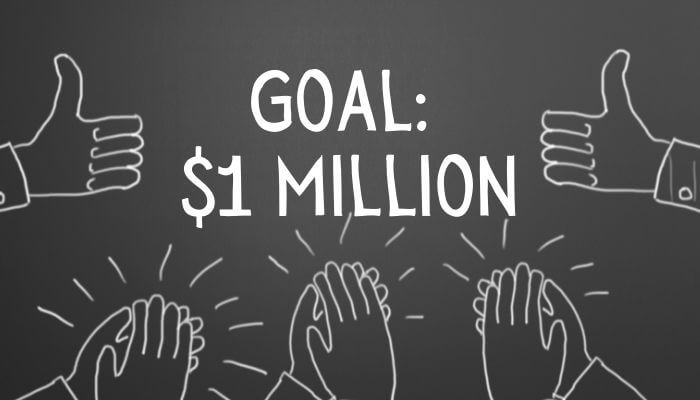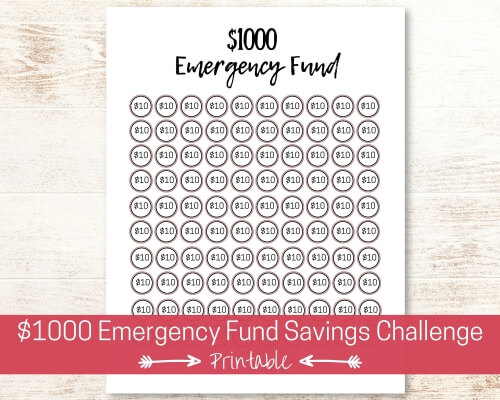
10 Financial Steps To Reach $1 million
Who doesn’t want to find the magic formula to reach $1 million? A million dollars seems to be THE financial goal for most people who are on the path of F.I.R.E. But even if you are not on the FI journey, there are still a lot of people who are looking for the secret way to turn $100 into $1 million fast.
Unfortunately, there is no one size fits all plan to meet this goal. But there are financial steps that you can take that will significantly increase your chances of reaching millionaire status.
Some of the links below are affiliate links. As an Amazon Associate we will earn a commission from qualifying purchases if you decide to make a purchase through our link, at no additional cost to you.
Here are 10 financial steps that you can take to help you reach your goal of $1 million:
1. Identify Your Financial Goals
Don’t just think about it – talk about it, write it down, tell someone, shout it from the rooftop and then repeat this daily.
Identify exactly what it is that you want and make a plan to get it. Don’t let fear hold you back from creating a life that you want for yourself.
Take the time to plan out the steps that you need to take in order to reach your goals. And don’t forget to celebrate each little win along the way.
Related Article: 5 Rules To Follow For Successful Goal Setting
2. Pay off debt
There’s that dreaded “D” word….debt. Most people have it, nobody likes it, but are you working hard enough to get rid of it?
Debt is one of those things that most people inevitably experience at some point in their lives. Whether it be from a mortgage, car loan, student loan or from credit card use. The problem isn’t so much that you have debt but how you plan (or don’t plan) on tackling it.
Becoming debt free, including paying off our mortgage, was the best feeling in the world for us. It was like a weight was lifted off our shoulders and that we instantly had a feeling of freedom back.
Paying off your mortgage can be a controversial topic in the FI community but I believe that you should always do what feels best and right for you and your family. And if you need that peace of mind and checking your mortgage debt off of your list does that, then go for it.
How do I get rid of debt?
There are many methods that you can use to get rid of debt and there is not a wrong answer to how you approach it. The important thing is that you acknowledge its existence, make a plan, and whittle it down down to 0 as fast as possible.
Debt Avalanche: In this method you pay off the biggest debt first – the one that charges the most interest.
Debt Snowball: In this method you pay off the smallest debt first – the one with the least total amount.
Which method should you choose to pay down your debt? There is no right or wrong answer. The important thing is that you are tackling it.
In the Debt Avalanche strategy you are working towards getting rid of the debt with the highest interest rate. This can potentially save you hundreds of dollars and take months off of your repayment time.
In the Debt Snowball strategy you are choosing one debt to pay off first. This will wipe one of them out quickly. Seeing this progress is a great motivator to keep going and tackle the next debt in line.
Related Article: How To Get Out Of Debt Fast
3. Build Up An Emergency Fund:
An emergency fund is something that you don’t realize that you need until it is too late.
It’s always a good idea to have an emergency fund. Whether you keep it in a separate account or it is just factored into your savings, you should always have “cash” available in case you need it.
An emergency fund can help you pay for medical emergencies/bills or unexpected car repairs or home repairs. It will also come in handy in the case of a job loss or lay off.
Having an emergency fund in place will definitely decrease the level of stress in any of these situations

How Much Money Should You Have In An Emergency Fund?
This number will vary depending on your lifestyle and individual situation but a general rule of thumb is to have three to six months of living expenses saved.
So in order to determine this number, you should start by tracking your expenses.
Which leads us to #3.
4. Track Your Expenses
I am a huge advocate for tracking your expenses. We have been doing it for a few years now and it is definitely eye opening to see how much you spend and where you spend it.
It is also a great way to figure out where you can cut expenses and to determine frivolous spending.
Tracking your expenses also gives you an idea of how much money you need per month upon reaching F.I.R.E.
5. Control Your Spending and Live Within (or below) Your Means
If you are trying to reach $1 million then this action can help to get you over that hurdle.
Sometimes it’s the small lifestyle changes that really add up. Controlling your spending or finding ways to cut costs will allow you to save a lot of money in the long run.
When you are trying to reach a financial goal, it can be very beneficial to live a little more frugally. Learning and utilizing different tips on how to save more will help to get you closer to that goal.
Of course you can get to $1 million without this step but for most people it will give them a way to boost their savings and investments.
6. Contribute To Your Retirement Accounts To Reach One Million Dollars Faster
Contributing to IRAs and a 401k can be a beneficial way to help you to build wealth.
The money that you put into retirement accounts gets invested right away. This is especially helpful if you are not someone who regularly invests. It is much easier for a non-investor to use these vehicles to get money into the stock market because you are using the money to “save for retirement.”
What are the benefits of contributing to my retirement?
A Roth IRA allows you to enjoy tax free retirement income. You have already paid taxes on the money going on so you will not be taxed when you withdraw. Another advantage of a Roth IRA is that you can withdraw your contributions without penalty.
A Traditional IRA is a tax deferred account. Your contribution to this type of IRA will lower your taxable income.
When you put money into your 401k, it goes in before taxes are taken out which means that your taxable income is lowered. It is also an automatic contribution that you set up, which is a great way to get your money invested without having to think about it each week.
A 401k also hopefully comes with some sort of match from your employer, which is essentially free money. Always take free money!
7. Max Out Your HSA
This tax advantaged account is a great retirement savings vehicle.
Yes it could have been included in #6 but I feel that it needs a category of it’s own.
It is true that you can use an HSA to just pay for medical expenses, but instead you should be thinking about it as a way to save and invest for retirement.
The advantages of an HSA
- Contributions to an HSA are made pre-tax, which lowers your taxable income.
- Investments will grow tax free.
- Withdrawals are tax free as long as the money is used to pay off qualified medical expenses.
You can contribute money to this account which gets invested and then leave it untouched, allowing your money to compound. To take full advantage of an HSA, you should use it as an investment tool.
8. Increase Your Income and Have Multiple Streams of Income
In Tom Corley’s 5 year study of “Rich Habits” he found that most self-made millionaires had multiple streams of income:
- 65 percent had three streams of income
- 45 percent had four streams of income
- 29 percent had five or more streams of income
So how do I get multiple streams of income? Where should I start?
Well you probably already have a few and just might have never thought about it in this way.
Here are 4 streams of income that you may already have:
- Earned Income: Your job! Your primary source of income.
- Interest Income: Any interest that you make from your bank accounts – Savings Accounts, CDs, etc.
- Dividend Income: Money that you receive for owning shares of a company.
- Capital Gains: Money that you earn when you sell an investment such as stocks.
How Do I Generate Additional Streams Of Income?
Creating multiple streams of income will not only help you to boost your finances but they may also be a way for you to expand your horizons, create new contacts, and open up a door of opportunity that may have not otherwise existed.
Here are some ways that you can give your income a boost and maybe make an extra $1000 per month in order to reach that $1 million mark faster:
1.Real Estate:
Having rental income from a vacation rental or multi-family homes is a great way to build wealth over time.
2. Side Hustles:
Become a Virtual Assistant, Freelance Writer on Upwork, Proofreader, or Transcriber. Deliver Groceries, Pet Sit, Flip items, Rent out your car, etc.
3. Create a business:
Become a Resume Writer, Photographer, a Freelance Website Developer or Graphic Designer. Sell on Etsy, Amazon, or Ebay. Become a Life Coach, Home Inspector, Translator, Landscaper, or Travel Planner. Create and sell a product.
The possibilities are endless.
9. Invest Early And Often
Early investing leads to compounding returns. Regular investments made earlier on in life will result in a higher yield. As you add to your investments over time, the overall sum increases and in turn, the sum of your returns increases as well.
Check out this infographic on Life Hack. I think that it is a lot more motivating to see the numbers rather than just talking about it.
Another reason to start investing early is to start gaining financial knowledge earlier on in life. We all start with zero knowledge but once you get your feet wet, you start to learn more about key investment terms, how the stock market works, and what your risk tolerance is.
Once you start to see the gains in your portfolio, you also start to get the investing bug which gives you the motivation that you need to keep adding to your investments.
When it comes to investing both time and consistency are key to reaching a million dollars.
10. Invest In Yourself and Your Future
One of the most important steps that you can take to help you to reach $1 million is to invest in yourself.
“Formal education will make you a living; self-education will make you a fortune.”
– Jim rohn
According to the Global Finance Literacy Excellence Center 63% of Americans are financially illiterate. This lack in knowledge includes topics such as interest, inflation, investing, savings, borrowing money/loans, financial risk, etc.
OppU has identified 10 eye-opening (and scary) financial literacy statistics which include:
- Two out of three families lack an emergency fund.
- 78% of adults live paycheck to paycheck
- 27 states in the U.S. scored a C,D, or F for high school financial literacy
You can read all 10 statistics HERE.
The Benefits of Increasing Your Financial Knowledge
People with higher financial knowledge are more likely to invest, plan for retirement, manage debt better, and be more prepared for financial bumps in the road.
It allows you to make smart money choices that you can be confident about.
Taking the time to increase your financial literacy will empower you, give you more control of your finances, and lead you down a more successful financial path.
4 Ways To Improve Your Financial Literacy
1. Read Personal Finance Books and Blogs:
There are tons of great resources out there for you to read and improve your financial knowledge.
Related Article: The Top 6 Personal Finance Blogs To Inspire You To Reach F.I.R.E
Book Recommendations:
2. Listen to Personal Finance Podcasts:
Podcasts are a great way to explore personal finance or to even get a different perspective on a topic that you are interested in.
Related Article: The 12 Best Financial Podcasts
3. Explore Community Events:
Search for opportunities within your community to attend a financial event or seminar or to listen to financial speaker. You may be able to find a specific workshop for budgeting or investing that will give you more insight and information. A live event may even give you the chance to talk to a live person and connect with others.
4. Network and surround yourself with like-minded people:
The people who you choose to surround yourself with can have a great influence on your values, thoughts, and actions.
“You are the average of the five people you spend the most time with.”
– Jim Rohn
If you surround yourself with like-minded people who have similar values and goals as you, they can help to elevate you to the next level.
If you hang out with positive, successful people, you are more likely to desire the same qualities and become a better version of yourself. They may influence you to want to change your life and to work hard to do so.
Final Thoughts On The Financial Steps to Take To Reach $1 Million
Getting to $1 Million is not impossible and out of reach.
The best way to reach this goal is to analyze your current financial situation and see where you can make improvements . Once you create a plan you just need to be consistent.
Hitting this milestone can take time but if you want it bad enough, you will get there.
Don’t let fear of failure hold you back. Learn from others but don’t compare yourself to others. Make deliberate choices to create wealth. And remember that it is not a race to the finish.
Additional Articles To Help You Reach Your Financial Goals
Chasing F.I.R.E: Financial Independence Retire Early
101 Inspirational Personal Finance Quotes and Sayings To Build Wealth
Why You Need To Ditch Your Scarcity Mindset To Create An Abundant Life



